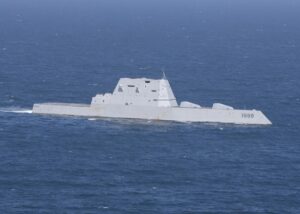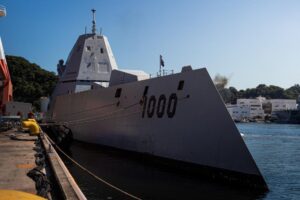The Navy’s first stealth destroyer recently came back from its first long-range employment that worked through maintenance and logistics, but next year it will start getting hypersonic missiles installed to bring it to a full payload.
The USS Zumwalt (DDG-1000) returned to its San Diego homeport on Nov. 10 after a three-month employment to the Western Pacific region that started Aug. 1.

“Zumwalt executed the employment exactly as planned and at every milestone that was set out in that plan. It’s also an important milestone for the DDG-1000 class and for the Navy…that employment was part of the fleet integration process of introducing a class of ship into the operational environment, and understanding how it can best support and operate with other ships and platforms,” Capt. Shea Thompson, commander of Surface Development Squadron (SURFDEVRON) One, told reporters on Wednesday.
“We made significant strides in learning how to employ, integrate and sustain Zumwalt as she operated forward. And this is a significant step forward for the future of this class. We do expect to capitalize on these lessons learned as we continue to employ the ship forward and integrate the platform into fleet operations and exercises,” he added.
DDG-1000 Commanding Officer Capt. Amy McInnis also said there were many lessons learned related to the ship’s communications systems, logistics, operating forward maintenance required and the infrastructure needed for that.
Thompson said while in the Indo-Pacific region the Zumwalt conducted joint and bilateral maritime fire training with the 613th Air Operations Center in Hawaii, Air Force B-1 bombers, a Japanese destroyer and the Commander Task Force-71 staff based in Japan.
The official said DDG-1000 did not include an aviation detachment during this period.
“That was to test combat systems capabilities while operating in 7th Fleet.”
Thompson also noted the ship worked on a mine countermeasure (MCM) proof of concept with a forward-deployed explosive ordnance disposal unit and air operations with the Army.
However, the officials would not elaborate on the MCM proof of concept beyond acknowledging it used the ships’ Rigid Inflatable Boats (RIB).
Thompson said he recognized the vision for the three-ship Zumwalt-class destroyer is to be a long-range maritime striker and that involves adding the Conventional Prompt Strike (CPS) hypersonic missile, but “you can’t do that mission without being excellent at all the other mission areas that the ship was designed to conduct.”
He said this employment helped the ship hone its abilities in all the other areas as well.

The Navy plans to install the missile tubes and CPS weapons in DDG-1000, replacing its unused gun system, during an 18-month maintenance availability over fiscal years 2024 and 2025.
Thompson laid out the future schedule as he noted the ship will have to do a lot of testing after the installation is complete to make sure it works as designed and expected.
“Right now the ship is scheduled to go into drydock late next year. And right now we’re looking at an 18-month drydock availability to complete this install. So you add a few months on the back end of that for CPS testing. And then a typical ship that goes through workups – it’ll take about a year to go through your basic phase, your advanced phase and your integrated phase where you’re ready and certified to deploy again.”
The Navy plans to field the hypersonic missiles on DDG-1000 by 2025, following the initial Army deployment in 2023. Later, the Navy plans to add the CPS to the first Virginia-class submarine equipped with the Virginia payload module by 2029.
Earlier this month, Vice Adm. Johnny Wolfe, the Navy’s director for Strategic Systems Programs, said the main challenge for integrating CPS onto the Zumwalt is the three-year timeline (Defense Daily, Nov. 8).
Despite all the future work required, Thompson argued DDG-1000 has reached Initial Operating Capability (IOC) now.
“I assess Zumwalt as being IOC today. And I think she just proved that by successfully completing the employment. Obviously, there’s some major work going on here in the future. for fiscal year ‘24 and ‘25. She’s going to come out of there and go into a lot of live fire testing, systems testing. She’s going to have to go through a whole other workup cycle, before she’s ready to employ or deploy again.”
The Zumwalt-class ships were built by General Dynamics’ Bath Iron Works [GD] shipyard in Maine. The hull and mechanical delivery for DDG-1000 was completed in May 2016, but the ship had to sail to San Diego in late 2016 for its combat systems activation, which was not finished until April 2020.
DDG-1000 was originally expected to reach IOC in 2015 under an original schedule of delivery in 2013 and combat systems activation in 2014.